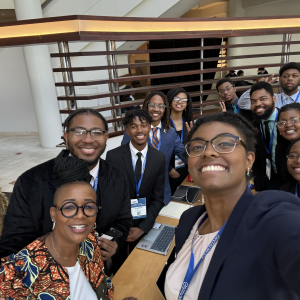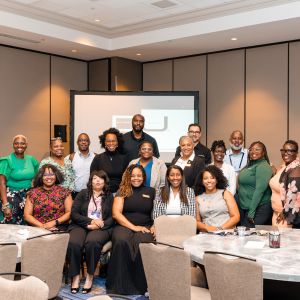The mass layoffs last March at the U.S. Department of Education’s statistical research group, the National Center for Education Statistics (NCES), was reason for concern for the National Society of Black Engineers. NSBE has long looked to the Center’s college and university degree attainment data to help measure our progress in increasing the number of Black Engineers in the U.S. At last look, however, the latest degree data in the NCES Digest of Education Statistics was for the 2021–22 academic year.
Other information from NCES is important to NSBE’s pre-college programs. Statistics from NCES are used to produce the Department of Education’s Civil Rights Data Collection, for example: a nationwide survey done every two years to determine public school students’ access to educational opportunities in grades K–12. A 2024 Civil Rights Data Collection report pointed out that only 47% of Black public high school students attended schools that offered a full range of math, science and computer science courses, compared with 69% of Asian American students and 55% of white students. In comments submitted to the Department of Education last September, the American Educational Research Association expressed concern about the ability of NCES to continue to provide high-quality information with the Center’s current resources.
For insight into recent federal education data policy related to diversity, equity and inclusion, we turned to NSBE National Advisory Board member Virginia Booth-Womack. Holding two Purdue bachelor’s degrees, in Industrial Engineering and Psychology, and now pursuing a Ph.D. in Engineering Education, Booth-Womack recently retired as director of Purdue’s Minority Engineering Program and now heads her own firm, Engineering Education Data Solutions.
Booth-Womack became a charter member of NSBE when it was launched at Purdue in 1975. Three years later, she became the first woman to serve as the Society’s national chair and was the first national chair to serve two consecutive terms (1978–80).
When did you begin as director of Purdue’s Minority Engineering Program?
Before we begin, please note that the views I share today are my own and do not represent the official positions or policies of the National Society of Black Engineers or Purdue University.
I became the director of the Purdue University Minority Engineering Program in the summer of 2004. Before returning to Purdue, I spent more than 18 years in engineering, where meeting rigorous throughput, manufacturing and product-improvement targets built strong professional resilience and a results-driven mindset.
Can you share any statistics that tell how students were helped by the Purdue MEP during your tenure?
Purdue publishes some student success data, but detailed breakdowns are often internal. As a retiree, I’m offering personal observations, not university policy. However, the dean of the College of Engineering had this to say during my retirement reception about student performance during my tenure as MEP director:
“During Virginia’s time as director of MEP, the four-year graduation rate for underrepresented minority engineering students improved by 110%. The four-year graduation rate for African American engineering students improved by 160%. In 2019, for the first time in the College of Engineering’s history, the five-year graduation rate for underrepresented minority engineering students exceeded the five-year graduation rate of the total engineering cohort.”
Achieving these outcomes involved a partnership of all levels of university leadership within and outside of the College of Engineering. Over the years, the development of a community of university and corporate leaders across gender and ethnicity was key to achieving success.
Please tell us about the company you launched this year, Engineering Education Data Solutions. What services does it provide? What led you to this area of work?
With my 18 years in engineering manufacturing and 21 years in academia closing achievement gaps and raising retention and graduation rates, EEDS brings both engineering operational savvy and education success experience. EEDS emphasizes excellence, pathway efficiency and talent development.
Can you provide some insight into what is and isn’t happening with the federal data NSBE has long relied on to track our progress in our mission? Are there alternative sources of data NSBE and other STEM DEI organizations can use?
Again, just to be clear up front, my perspective on this subject is drawn from my personal research and experience and is not an official statement from Purdue, NSBE or the federal government.
Performance data released at the national level reflects past performance. The absence of national performance data does not prevent NSBE from making progress on the mission.
NSBE’s mission connects directly to a long U.S. legacy: from the 1965 Elementary and Secondary Education Act’s focus on standardized tests, access and equity (former President Johnson’s administration), to today’s emphasis on promoting engineering talent and global competitiveness without a DEI focus (current President Trump’s administration). NSBE’s value as it relates to engineering talent production resonates in both climates. Because federal policy and historical data regimes are shifting, NSBE’s continued focus on academic and professional excellence must become policy-resilient. NSBE’s ability to promote rigorous readiness for our members, build strong support infrastructures tailored for non-cognitive and cultural success factors, and generate our own (real-time) outcomes data creates a unique vantage point for moving forward. Regardless of changes in governmental priorities or data transparency, NSBE remains positioned to deliver high-quality, competitive engineering talent.
In the absence of historical data, I would suggest that NSBE consider focused initiatives in the following areas:
- Access and readiness: Ensure that NSBE Jr., Collegiate and Professional members meet rigorous standards at all levels of membership .
- For Pre-College Initiative (PCI) chapters, assessing every current and new member in reading and math proficiency will provide local and national data to understand barriers to learning. The goal set across the nation to improve proficiency can be a point of annual celebration.
- Showcase professional member certifications, training and accomplishments.
- Support infrastructure: Non-cognitive supports
- Socialize and promote non-cognitive support system activities to enhance community and belonging within and across member chapters. Measure locally and nationally, celebrating best practices.
- Measurement and Outcomes: Track student success, persistence and professional transition. NSBE should generate its own robust data and evidence of impact.
- Continue to track GPA performance metrics for APEx members with an added focus on the lowest performance areas. Add a “most improved” focus that is based on the target “gateway courses.”
- Partner with professionals and corporate supporters to develop gateway course mastery/certification efforts
- Excellence Framing: Position NSBE students/programs as high-performing, globally competitive engineers.
- Align with national talent imperatives.
- Strengthen NSBE’s national and global value proposition.
Thank you for the opportunity to share my thoughts.








